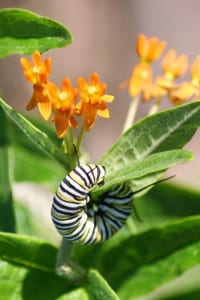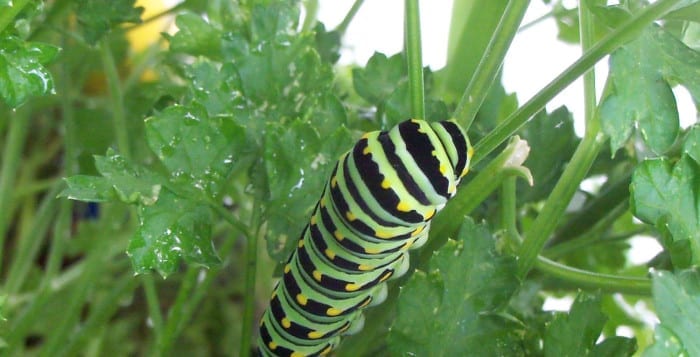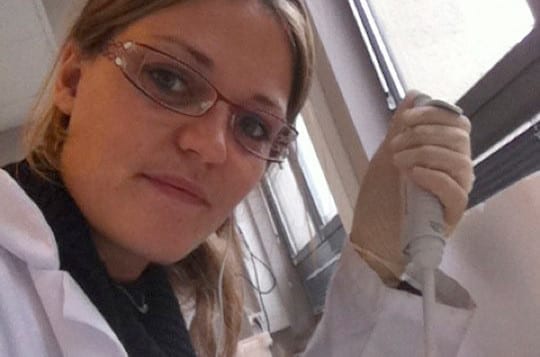By Ellen Barcel
There are many gardening chores to accomplish in the fall. One that I’m currently working on is bringing in some herb plants to try and keep them growing over winter. Mainly, I want to keep some of my mints growing, but the parsley plant is lush and gorgeous, so I’m going to make a stab at keeping that growing on a bay window. When I went to take a look at the plant, I saw an absolutely beautiful caterpillar on one of the stalks. I knew it wasn’t a monarch, because they go for milkweed (several dined on my butterfly weed, Aesclepias tuberosa, a native variety of milkweed), and besides they have orange strips while my new guest was basically green and black.
Parsley worm caterpillar
A bit of research told me that it was a parsley worm caterpillar, which would eventually change into an American swallowtail butterfly, black with blue markings. How was I going to deal with this critter since I really wanted to see it turn into a butterfly, but I also wanted to bring the parsley into the house so I’d have fresh parsley all winter.

Again, research told me that they overwinter in the garden as a chrysalis (that is, a pupa) and emerge from the cocoon in spring (April to May usually) as the beautiful butterfly. So, if you are bringing any plants into the house, check them for hitchhikers. Break off some of the parsley and set it with the caterpillar in a safe place outside to overwinter. I’ve read that it’s a nasty tasting caterpillar so birds tend to leave it alone.
Some people object to the parsley worm (which is attracted to other plants in the carrot family, such as dill, carrots and Queen Anne’s lace). They can be hand picked off the plants if you want. Personally, I don’t mind sharing a bit of my parsley with them knowing that they will turn into beautiful butterflies.
Green tomato hornworm
Another caterpillar you may find on your garden plants is the large green tomato hornworm. I remember as a kid my father finding them on some tomato plants he was growing. One was covered with white insect eggs, parasitized by braconid wasps. My father removed the caterpillar with the eggs, but I later learned that the wasps perform a valuable service to the home gardener, that of devouring other insect pests.
Like the parsley worm caterpillar, they can be easily removed from the plant by hand picking. While the parsley worm will eventually yield a beautiful butterfly, the tomato hornworm can quickly defoliate tomato plants (and other nightshade plants like potatoes, peppers and eggplants) causing serious damage to the garden.
After going through the pupa stage, a large moth will emerge. No, I’m not willing to share my tomato plants with these critters. But, if you find one covered in white eggs, leave it alone since the wasps that will emerge from the eggs will kill the caterpillar and control other insect pests.
So, monarch butterfly caterpillars are good, parsley worm caterpillars are also very good and tomato worm caterpillars are bad, unless they’re covered in wasp eggs.
There are many other varieties of caterpillars that are sometimes beneficial and sometimes not. Remember the gypsy moth caterpillar can be very bad. (See my column of last July 16 for details on this one.)
Check out any caterpillars you find by typing the description into your computer’s search engine to find similar photos to help identify it. Only when you know what you have, should you decide what to do about the critter or critters in your garden.
Ellen Barcel is a freelance writer and master gardener. Send your gardening questions to [email protected]. To reach Cornell Cooperative Extension and its Master Gardener program, call 631-727-7850.






